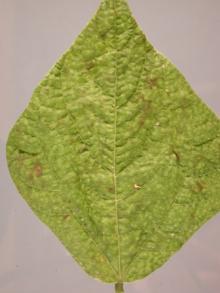See:
Bean, Dry Varietal Resistance to Bean Common Mosaic
Cause Bean common mosaic virus (BCMV) is transmitted by both seed and aphids. The virus occurs wherever beans are grown and many strains of the virus exist. Some varieties are resistant to several strains of BCMV but no commercially available variety is resistant to all strains.
Symptoms Infection by BCMV causes a light and dark green mottle or mosaic pattern on leaves, which may also exhibit a downward curling or cupping and general malformation. The mosaic symptom may be associated with and follows the network of leaf veins, which become slightly darker than the interveinal area ("vein banding"). Another symptom of infection is veinal necrosis or "road mapping" of leaves. Systemic necrosis (black root reaction), characterized by black vascular tissue in stems and pods, and plant death may occur in some varieties with a specific type of resistance gene (the dominant I gene) to BCMV. Plants from BCMV-infected seed or plants infected very early in the season are dwarfed and spindly, and yield often is reduced. Infection also can result in deformed pods or pods that show brown discoloration in wall and suture.
Cultural control
- Use virus-tested seed.
- Plant resistant varieties such as Oregon 91G, Oregon 54, Roma II, BB 110, and Goldrush. Most commercial dry bean varieties and many snap bean varieties are resistant to one or more strains of BCMV but can be susceptible to other, less common strains.

